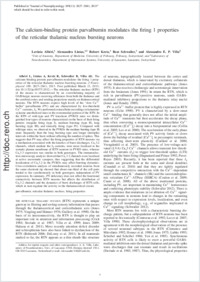The calcium-binding protein parvalbumin modulates the firing 1 properties of the reticular thalamic nucleus bursting neurons
- Alberi, Lavinia Unit of Anatomy, Department of Medicine, University of Fribourg, Switzerland
- Lintas, Alessandra Unit of Anatomy, Department of Medicine, University of Fribourg, Switzerland - Laboratory of Neuroheuristics, Department of Information Systems, University of Lausanne, Switzerland
- Kretz, Robert Unit of Anatomy, Department of Medicine, University of Fribourg, Switzerland
- Schwaller, Beat Unit of Anatomy, Department of Medicine, University of Fribourg, Switzerland
- Villa, Alessandro E. P. Laboratory of Neuroheuristics, Department of Information Systems, University of Lausanne, Switzerland
-
06.01.2013
Published in:
- Journal of Neurophysiology. - 2013, vol. 109, no. 11, p. 2827–2841
English
The reticular thalamic nucleus (RTN) of the mouse is characterized by an overwhelming majority of GABAergic neurons receiving afferences from both the thalamus and the cerebral cortex and sending projections mainly on thalamocortical neurons. The RTN neurons express high levels of the “slow Ca²⁺ buffer” parvalbumin (PV) and are characterized by low-threshold Ca²⁺ currents, IT. We performed extracellular recordings in ketamine/xylazine anesthetized mice in the rostromedial portion of the RTN. In the RTN of wild-type and PV knockout (PVKO) mice we distinguished four types of neurons characterized on the basis of their firing pattern: irregular firing (type I), medium bursting (type II), long bursting (type III), and tonically firing (type IV). Compared with wild-type mice, we observed in the PVKOs the medium bursting (type II) more frequently than the long bursting type and longer interspike intervals within the burst without affecting the number of spikes. This suggests that PV may affect the firing properties of RTN neurons via a mechanism associated with the kinetics of burst discharges. Cav3.2 channels, which mediate the IT currents, were more localized to the somatic plasma membrane of RTN neurons in PVKO mice, whereas Cav3.3 expression was similar in both genotypes. The immunoelectron microscopy analysis showed that Cav3.2 channels were localized at active axosomatic synapses, thus suggesting that the differential localization of Cav3.2 in the PVKOs may affect bursting dynamics. Cross-correlation analysis of simultaneously recorded neurons from the same electrode tip showed that about one-third of the cell pairs tended to fire synchronously in both genotypes, independent of PV expression. In summary, PV deficiency does not affect the functional connectivity between RTN neurons but affects the distribution of Cav3.2 channels and the dynamics of burst discharges of RTN cells, which in turn regulate the activity in the thalamocortical circuit.
- Faculty
- Faculté des sciences et de médecine
- Department
- Département de Médecine, Médecine 3ème année
- Language
-
- English
- Classification
- Biological sciences
- License
-
License undefined
- Identifiers
-
- RERO DOC 118166
- DOI 10.1152/jn.00375.2012
- Persistent URL
- https://folia.unifr.ch/unifr/documents/303166
Statistics
Document views: 131
File downloads:
- pdf: 335
